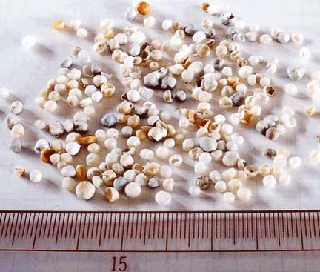WANTED
Looking for information on unidentified garbage
Although multiple pieces of such garbage have been found at the coastal areas, their names and usages are not known.
If you have seen the following products before, please kindly provide us with information.
If we know what the products are used for, we can prevent them from further runoff, drifting, and dispersion.
Unknown garbage found at the Midway Atoll northwest of the Hawaii Islands
Large volume of this garbage is found not at the coast but inland where the Laysan albatross nests.
From the way the garbage is scattered, it is likely that the Laysan albatross mighthave ingested the garbage by mistake and brought them inland.
<<?
They are black or grey plastic items of approximately 3 cm in size.
They are flat pieces in the shape of an "L".
There are grooves on both sides.
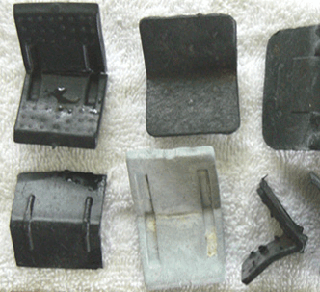
?>>
Plastic items with a diameter of 10 cm. They are found
along the man-made seashore of the Chiba Port Park.
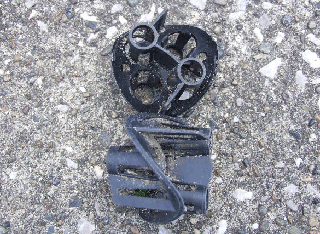
We found out what the following garbage items are.
Thank you for your cooperation in providing us with information.
It was found that they are the tips of the device for catching sea eels (June 2010) >>
They are black plastic items with a diameter of approximately 3.5 cm.
They are in the shape of a ball but half of the sphere is flat or caved.
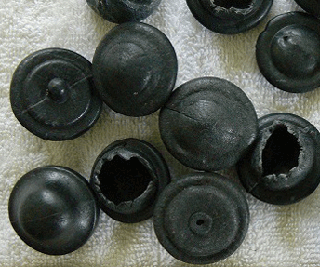
<< Part of water-purifier tank for disposer
Description: Black cylinder (net-like) plastic items, 3 cm in length and 2.5 cm in diameter.
A disposer in kitchen sinks used for crushing raw refuse is commonly used in apartments of the Tokyo Metropolitan Area. There are many types. This part is used in the water-purifier tank for filtering solid materials.
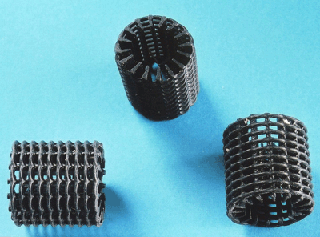
Filtering material in large-sized water tanks
Description: White plastic balls with a diameter of 3cm
These are special filtering materials used in the filtering tank of large water tanks (large-sized overflow equipment commonly known as "dry towers")used in stores that sell tropical fish.They are believed to be disposed of by Japanese engaged in the hobby of keeping fish.
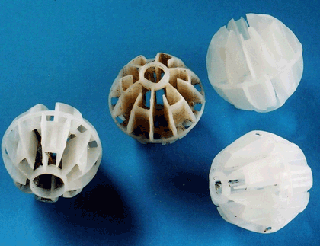
Pipes and washers used for farming oysters
These pipes and washers are used for the suspension-type oyster farming practiced in the Seto Inland Sea and other areas.
In oyster farming, 1.5-cm pipes known as "bean-sized pipes" are inserted in between scallop shells to be planted with seed oysters during seed harvesting to maintain intervals between the shells. When the oysters are introduced to the nursery, such pipes are replaced with the 20-cm long pipes (depending on the farming site, some may use ropes instead). The washers are used as the fixtures. One floater has approximately 24,000 pipes.
<< Pipe-shape
Black or blue plastic pipes.
The diameter of the hole is approximately 1cm
and the length is 15 - 30 cm.
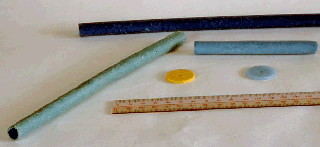
<< Bean-sized cylinders
Black or blue plastic cylinders.
The diameter of the hole is approximately 1 cm and the length is 1.5 cm.
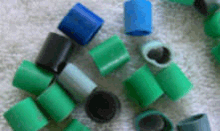
<< Washer-shape
Plastic items in pink, yellow, and other bright colors.
They are about the size of a 500-yen coin, with a hole in the middle and are about 2 mm thick.
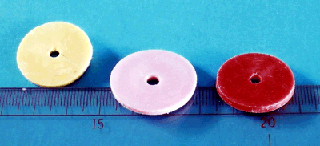
Some of these are washed away to the northwestern Hawaiian Islands. The discovery of these pipes in the carcasses of albatross chicks by Professor Rick Steiner of the University of Alaska created an outcry.
<<The photo is taken in 2005 along the coast of Hawaii's Oahu Island. The long pipe in the middle is used for oyster farming in Japan. There are some coastal areas where over a thousand pieces of these pipes are found at one time.
*These long pipes are used only in Japan.
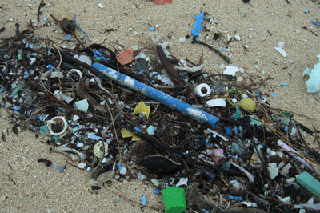
Cords for cultivating oysters and sea squirts. >>
Description: Black or grey plastic cords with many knots. They are about 20-30 cm in length.
These cords are used in Korea for cultivating oysters and sea squirts. The knots are made to maintain intervals between the shells. It is believed that the cords are cut at various intervals during harvest.
This explains why the cords are found with knots, such as the ones shown in the photo.
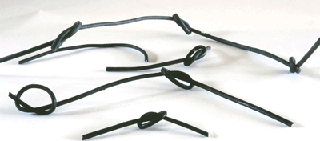
<< Rings for preventing barnacles
Description: Rings made of plastic tubes, or rings made of packaging straps. Most of these rings have diameters of approximately 10 - 15cm. *The sizes and materials vary.
In laver culture, these rings are attached to the support poles to prevent barnacles.
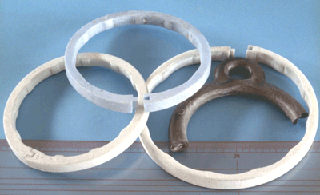
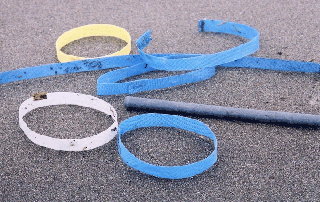
Resin pellets >>
Description: Made of hard plastics. These pellets are about 2 - 4 mm in size. Many of them are white or half transparent, although there are also other colors.
Resin pellets are intermediary materials for making plastic products. They vary from the transparent ones to colorful ones. Their sizes and shapes also differ. These pellets are melted to add colors or processed by adding additives for specific purposes.
There are concerns about the ingestion of these pellets by mistake since they have been found in the digestive systems of seabirds and fishes.
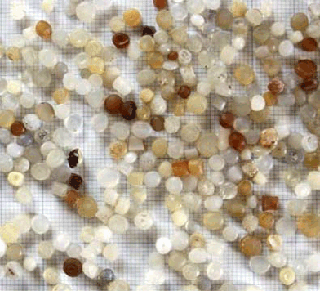
<< Shells of coated fertilizers (Capsules for sustained-release fertilizers)
Description: 2 - 3 mm capsules that are hollow inside.
After the fertilizer flows out, the inside of the capsule becomes empty. It can be crushed easily.
The size and shape of these capsules are similar to those of the resin pallets; however, they are different in that their insides are hollow.
Chemical fertilizers are coated with resin. The fertilizer seeps out gradually to match the growth of the crops. Together with dried seaweeds, huge amountsof such capsules have been found clustered on sand beaches.
